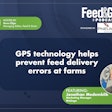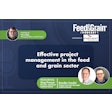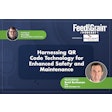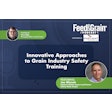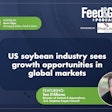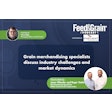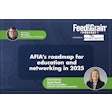Steven Kilger, host of the Feed & Grain Podcast, chats with Clement Soulet, global additive category manager of Cargill Animal Nutrition, about the company's 2022 World Mycotoxin Report.
The report is based on an analysis of over 135,000 raw material samples from across the globe, and is the largest and most in-depth study of mycotoxins in the industry. Soulet explains how the data was gathered and how Cargill uses the information to mitigate the impact of mycotoxins on animal production. He also discussed the importance of sharing the information to raise awareness of mycotoxin contamination.
Transcript
Steven Kilger (0:00):
Hello, everyone, welcome to the Feed & Grain podcast. I want to thank you so much for listening. My name is Steven Kilger. I'm the managing editor for Feed & Grain Magazine and also your host. We have a great show for you today.
Clement Soulet, the global additive category manager at Cargill Animal Nutrition, stopped by to talk about Cargill's recently released 2022 World Mycotoxin Report. If you're unfamiliar with the report, it was created from analyzing 135,000+ raw material samples from across the globe, creating the largest, most in-depth look into mycotoxins in the industry.
Clement breaks down how the report is created, what it contains, and how Cargill uses the data to help mitigate the effects of mycotoxins in animal production. I found the conversation really, really fascinating, and I hope you do as well.
But before I can get to that, I have just a little bit of housekeeping. If you're listening to this podcast within a podcast app, please consider subscribing and or leaving a review. It really helps the podcast out. If you have an idea or topic you'd like me to cover. Let me know. This podcast page on feedandgrain.com has a button right under the title that will let you send an email directly to me. I'd love to hear from you and talk to you about the podcast.
Alright, enough housekeeping onto the conversation itself.
Morning Clement, Thanks for talking to me today. Can you tell our listeners a bit about yourself? Can you tell me a little bit about yourself and what you do at Cargill?
Clement Soulet (1:31):
Yeah, absolutely. So I'm a French agronomist, and I've been working most of my career in animal production and most particularly on the feed additive space. So in 2018, I joined Cargill Animal Nutrition and lead the global additive team. I'm still part of this. It's one global additive team, which encompasses the legacy Cargill Animal Nutrition additive business, but also the Diamond V portfolio and the Delacon portfolio as well. This is why I say one wider global additive team.
Kilger (2:12):
Yeah, it sounds like it's kind of amazing considering how huge Cargill is that you guys get to kind of come together and be one team.
Soulet (2:20):
Yeah, that's an exciting project with quite some focus on it. We call it the “Mycoverse.” So the universe of Mycoingredients. It's kind of the internal way of describing this new one global additive team. And in this team, my role is to supervise the execution and deployment of the anti-mycotoxin solutions. So that's why I'm here today.
Kilger (2:41):
Very cool. Well, that kind of brings us to the first question, which is this World Mycotoxin Report that you guys put out, this is your second year doing it. So why did you decide to put out this report? And put it together and then put it out that way?
Soulet (2:59):
So I would say two things. First is we are an active player in giving to our customers solutions to mitigate mycotoxin risk or mycotoxin issues. But before providing the solution, you need to explain what the issue is. What is the pain? So showing where mycotoxin is, and what the contamination is, and the different regions are, it is also part of the process. You need to explain why it's impacting. And then you can come up with the solution. And for this database, we are also proud to own the world's largest mycotoxin contamination database with more than 300,000 analyses for raw material samples that we collect every year.
That aggregated data can be pretty important, an interesting tool for many in the industry, and of course for Cargill itself. Because we are also highly interested to know where the mycotoxin pressure is, then act accordingly. And I think this is also something that is important for our customers' contacts network to be aware of, is not to just keep it secret. It's also to share this vast insight and experience and it's a way to give a footprint on the global understanding of mycotoxin contamination.
Kilger (4:19):
Well, it's a fascinating report. I always love reports that have nice graphics and stuff because as I tell people I basically became a journalist in order to be a student forever and like those nice global maps. It's a great report, for anyone listening if you haven't checked it out, there'll be a link in the description. Please do it's really fascinating read. How was the data for the report gathered and then turned into the world mycotoxin report?
Soulet (4:44):
That was a massive data centralization effort. We manage to get in one place all the mycotoxin analysis performed at our Cargill laboratories, and it's coming from hundreds of locations. These can be from our animal nutrition business, like the feed mills where we get truckloads of many ingredients and we test them. So that's one, but that also comes from our grain trading business, some food and ingredient processing business. And that will also come from samples collected at customers, and analyzed by ourselves in our facilities. That's all the data that we managed to put in one place to see the contamination level for a lot of different materials coming from a lot of different countries and places.
Then, to make the report, we talk about the risk performance level, like what is the percentage of finalities, above the risk performance level. So that's another aspect of the report. And for this, we have done some important work to define these performance risk levels. And maybe we'll come back to that later. But that's these two. So getting the analysis number, and then getting all the risk level estimation, and then we can do this global reporting in this place, you have this level of risk for the animal. And here, we don't talk about the regulatory risk level. And this is really the performance level for the animals.
Kilger (6:17):
So I did notice mycotoxin contamination levels increased a little bit in the 2022 report versus the 2021 report, which I assume is for a lot of different reasons. Can you go a little bit into why you think that little bit of an increase happened?
Soulet (6:32):
Yeah, so there are two ways of seeing that. For one, we say that in 2022, we have 75% of these 300,000 analyses, which were positive, and it's 3% more compared to last year. So that's what we call a prevalence increase, we see more positive results or more positive analysis, this can be due to better detection, on one hand, on the other hand, this can be also due to higher contamination. So it's also interesting to look at what other levels of contamination are, and when looking at the level of contamination, we also see an increase. So it means there are higher Zearalenone levels, or higher T2 levels or higher Aflatoxin levels taking these three as an example.
So we see this analysis of both our let's say performance ratios increasing 4 percent. So yes, there is an increase, which is maybe due to better detection ability, and the more you look for mycotoxin, you're more you find it. But that's also higher levels that are being measured. And I believe this can be multifactorial. One is called seasonal weather variation, when you have changing weather pattern, your mycotoxin contamination levels may vary, It does not mean that it will always increase but in some cases, you are inducing more stress to the plant and then you see more mycotoxin produced, then talking about global level, that's kind of difficult, you know, then to go into details and explain, “Okay, in these parts of the world, it was warmer, or much more humid during the harvest, and then it explain more or less mycotoxin presence.”
But then there can be also, and I believe this is an important factor, when you have use of different raw materials, like alternative ingredients sometimes you find more contamination in the byproducts. So in years, where raw materials are very expensive, you see more usage of byproducts, for example, distillers grains, and these are usually more contaminated. So that can also boost the level of mycotoxin overall. And then there are also other factors in agricultural practices, we see less and less dilate, for example, in some places, lower fungicide usage, and that can increase the mycotoxin level. So that's why I'm saying it's multifactorial, but I believe the two main reasons would be weather patterns, and also changing somehow the ingredients that are used in animal production.
Kilger (9:09):
Wow, it's complicated, it sounds like there's a lot going on, it must change so much depending on what region you're from. Right. And looking at the report, you can see that I mean, even Cargill, which is this huge, like some areas of the world, you don't have complete data. With weather changes and everything like that, too. It seems like you're gonna have mycotoxins that you didn't usually have to deal with just because you have completely different weather systems than you had last year because of climate change and how that's all happening.
Soulet (9:37):
Exactly. It's very hard to predict and to really say, “Okay, this is how it will look like next year.” But that's why we believe it's important to monitor because that's complex. As you said, it's very complex. It's not just, “oh, it's warmer than I have more aflatoxin” is not that simple. So you really need to monitor, because it's really multifactorial, the mycotoxin. So it's important to monitor and this is why Cargill will keep doing so much analysis to make sure that we are really able to monitor the mycotoxin level of the grain we use that we trade or that we sell. And that's something important: monitoring, making analysis. So for sure, in the future, we'll keep doing analysis, probably more and more, as long as the regulatory aspect is asking for more and more testing of mycotoxins.
Kilger (10:26):
Was there anything in the report that kind of surprised you now that this is your second year into it? Are you any patterns or anything that you're seeing that you're like, Okay, interesting.
Soulet (10:36):
To me, something which I found very interesting on the first report, and which was confirmed with the second report is the high level of contamination. Because sometime looking at a publication or the report, the level of contamination was said to be, I don't know 40%, 50%, 60%. But actually, we've seen that 75% of the analyses were positive, and above 90% of the samples were contaminated with at least one mycotoxin. So that's really high, it's a very high level of contamination. And maybe the second aspect that we managed to do for the second edition is monitoring the low contamination for multiple contamination. And what is interesting is that we're not big surprises, but interesting. The more mycotoxin you test for, the more you'll find, and typically, for the samples that were tested for three mycotoxins, 5% were above detection limits for two or three mycotoxins. So co contamination is really the rule. So it's something which is interesting, because when you have multiple contamination, you may have more issues, more challenges for your animal.
Kilger (11:49):
Well, I read one of your, I don't believe it's you, it's your colleague that had the column on the mycotoxin impact calculator that you guys are putting out, which really seems like an interesting innovation that Cargill is offering its customers, can you tell me a little bit about it?
Soulet (12:03):
As I mentioned, it's important to show first. Where are the various pains or where is the issue. And then it's very important to show how much this is impacting the operation, because sometimes mycotoxins can be the easy guilty party, the invisible guilty party, as well. So its important to put numbers on that and realistic numbers on that. So we've been developing an equation to say, okay, with this level of mycotoxin, these are the real symptoms you will observe.
Sometimes you will not observe any significant symptoms, but then this is the performance loss you may lose, then sometimes, it's just 5% performance or 1% performance, but when you raise a lot of animals, five or one percent performance loss can really impact the bottom line. So this is a calculator where you enter the mycotoxin level, and then it will tell you, okay, for this for the species are the subspecies you are interested in, this is the real impact you may observe and this is the real performance loss you will have, then it will offer the suggestion for an anti mycotoxin usage at the recommended dose. And then it will tell you, Okay, based on the loss, you have an investment you will do on an anti-mycotoxin product, this is the return on investment you will do.
Kilger (13:24):
Really interesting, this entire project. The reason it fascinates me so much is it seems like the future, this is something that our technology has finally allowed us to do. And it's really interesting that you guys are taking advantage of it. And now offering a solution as well, you're able to do more than just point out the problem, you're able to come up with, oh, this is the solution. This is what you should do to mitigate it. That's fascinating.
Soulet (13:47):
This is very important. Because we are also users of this, as in many countries, we also produce feeds. So mycotoxin is a concern. We also produce meat protein as well. So this is important and has a performance impact. How much should I invest in an anti-mycotoxin solution to do some good return on investment? We don't want to go with a blind approach, blinded approach. So that's something we want to bring to the customer because we believe this is the best way to be seen as a trusted adviser in that space.
Kilger (14:17):
Excellent. Well, those are all the questions I have and you want to bring up.
Soulet (14:21):
No, I mean, thank you very much for the invitation. I think that's a really exciting topic. We still have a lot to discover and we are resting on that space as well, so I'm sure we will discuss it again in the future to talk about new exciting stuff on mycotoxins.
Kilger (14:36):
Yeah, I hope so. keep us in mind for anything you come out with and hopefully we can talk next year once the 2023 report comes out. Thank you so much for joining me and thank you everyone for listening and stay safe out there.
.jpg?auto=format%2Ccompress&crop=faces&fit=crop&h=48&q=70&w=48)






